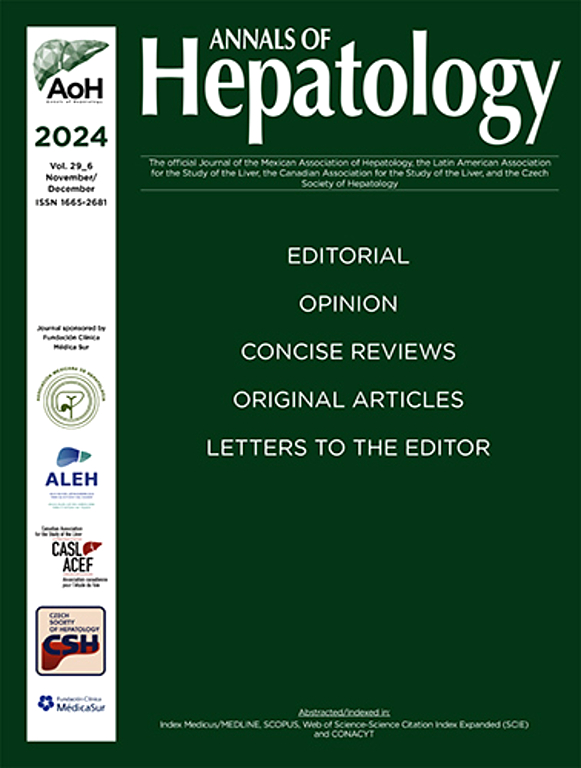Improvement in renal function after switching from entecavir to tenofovir alafenamide in chronic hepatitis B patients with low estimated glomerular filtration rates
IF 3.7
3区 医学
Q2 GASTROENTEROLOGY & HEPATOLOGY
引用次数: 0
Abstract
Introduction and Objectives
Tenofovir alafenamide (TAF) and entecavir (ETV) are both considered renal-friendly nucleoside/nucleotide analogs (NAs). However, the difference between ETV and TAF in terms of renal function remains unclear. This study aims to compare the renal safety profiles of two antiviral medications directly and evaluate the impact of switching from ETV to TAF treatment on renal function in chronic hepatitis B (CHB) patients with low estimated glomerular filtration rates (eGFR).
Patients and Methods
A total of 179 CHB patients who received TAF (n = 84) or ETV (n = 95) between 2019 and 2023 were included in the study. Changes in eGFR levels between two treatment groups from baseline to 72 weeks were compared to measure the influence of these NAs on renal function.
Results
At baseline, 84 patients were included in each treatment group after a 1:1 propensity score matching process. At week 48, a notable different changes in eGFR were observed between the two groups. Gender, baseline eGFR, and medication (TAF/ETV) were significantly correlated with eGFR abnormalities. Furthermore, eGFR abnormalities at week 48 led to the transition of 6 patients in the ETV group to TAF. eGFR significantly increased (83.60 ± 5.45 vs. 93.39 ± 9.88 mL/min/1.73 m2; p = 0.031) and serum creatinine significantly decreased (81.47 ± 11.36 vs. 74.9 ± 10.67 μmol/L; p = 0.046) from week 48 to 60. At week 48, the incidence of low-level viremia (LLV) was 19.0 % in the ETV group and 16.7 % in the TAF group, respectively (p > 0.05). Pairwise comparisons revealed no significant difference in the percentage of LLV between the ETV continued group and the TAF continued group at week 48, 60, and 72. Additionally, there was also no significant difference in the proportion of LLV between the ETV + TAF combination group and the TAF + ETV combination group at week 48, 60, and 72.
Conclusions
There was a substantial difference in eGFR between ETV and TAF treatments at week 48. Gender, baseline eGFR, and medication (TAF/ETV) were all remarkably positive indicators of eGFR abnormalities. In patients receiving ETV, an early switch to TAF may result in the reversal of early-stage renal damage.

低肾小球滤过率慢性乙型肝炎患者从恩替卡韦转为替诺福韦阿拉那胺后肾功能的改善
简介和目的:替诺福韦(TAF)和恩替卡韦(ETV)都被认为是肾脏友好的核苷/核苷酸类似物(NAs)。然而,ETV和TAF在肾功能方面的差异尚不清楚。本研究旨在直接比较两种抗病毒药物的肾脏安全性,并评估从ETV治疗转向TAF治疗对肾小球滤过率(eGFR)低的慢性乙型肝炎(CHB)患者肾功能的影响。患者和方法:2019 - 2023年间接受TAF (n=84)或ETV (n = 95)的179例CHB患者纳入研究。比较两个治疗组从基线到72周的eGFR水平变化,以测量这些NAs对肾功能的影响。结果:基线时,在1:1倾向评分匹配过程后,每个治疗组包括84例患者。第48周时,两组间eGFR变化明显不同。性别、基线eGFR和用药(TAF/ETV)与eGFR异常显著相关。此外,第48周eGFR异常导致ETV组中6例患者转变为TAF。eGFR显著升高(83.60±5.45 vs 93.39±9.88 mL/min/1.73 m2);p=0.031),血清肌酐显著降低(81.47±11.36 vs. 74.9±10.67 μmol/L;P =0.046)。第48周时,ETV组低水平病毒血症(LLV)发生率为19.0%,TAF组为16.7% (p < 0.05)。两两比较显示,在第48周、60周和72周,ETV组和TAF组的LLV百分比没有显著差异。此外,在第48周、第60周和第72周,ETV+TAF联合组和TAF+ETV联合组的LLV比例也没有显著差异。结论:第48周时,ETV和TAF治疗组eGFR有显著差异。性别、基线eGFR和用药(TAF/ETV)都是eGFR异常的显著阳性指标。在接受ETV治疗的患者中,早期改用TAF可能导致早期肾损害的逆转。
本文章由计算机程序翻译,如有差异,请以英文原文为准。
求助全文
约1分钟内获得全文
求助全文
来源期刊

Annals of hepatology
医学-胃肠肝病学
CiteScore
7.90
自引率
2.60%
发文量
183
审稿时长
4-8 weeks
期刊介绍:
Annals of Hepatology publishes original research on the biology and diseases of the liver in both humans and experimental models. Contributions may be submitted as regular articles. The journal also publishes concise reviews of both basic and clinical topics.
 求助内容:
求助内容: 应助结果提醒方式:
应助结果提醒方式:


